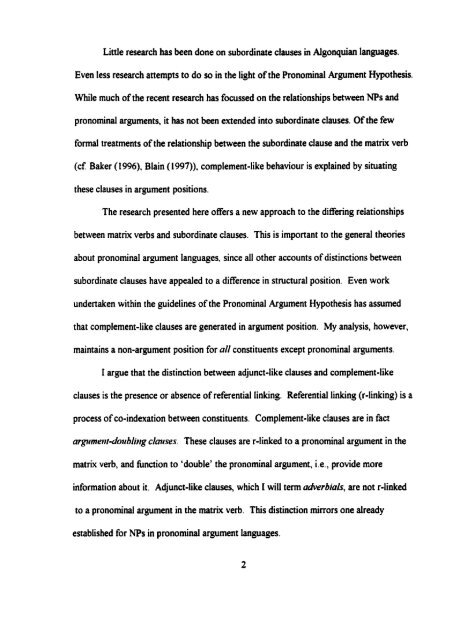Adverbial and Argument-Doubling Clauses in Cree - MSpace
Adverbial and Argument-Doubling Clauses in Cree - MSpace
Adverbial and Argument-Doubling Clauses in Cree - MSpace
You also want an ePaper? Increase the reach of your titles
YUMPU automatically turns print PDFs into web optimized ePapers that Google loves.
Little research has been done on subord<strong>in</strong>ate clauses <strong>in</strong> Algonquian languages.<br />
Even less research attempts to do so <strong>in</strong> the light of the Pronom<strong>in</strong>al <strong>Argument</strong> Hypothesis.<br />
Mile much of the recent research has focussed on the relationships between NPs <strong>and</strong><br />
pronom<strong>in</strong>al arguments, it has not been extended <strong>in</strong>to subord<strong>in</strong>ate clauses. Of the few<br />
forma1 treatments of the relationship between the subord<strong>in</strong>ate clause <strong>and</strong> the matrix verb<br />
(cf Baker (1 9%).<br />
Ma<strong>in</strong> ( 1997)). complement-like behaviour is expla<strong>in</strong>ed by situat<strong>in</strong>g<br />
these clauses <strong>in</strong> argument positions.<br />
The research presented here offers a new approach to the difer<strong>in</strong>g relationships<br />
between matrix verbs <strong>and</strong> subord<strong>in</strong>ate clauses. This is important to the general theories<br />
about pronom<strong>in</strong>al argument languages, s<strong>in</strong>ce al1 other accounts of dist<strong>in</strong>ctions between<br />
subord<strong>in</strong>ate clauses have appealed to a difference <strong>in</strong> structural position. Even work<br />
undertaken wit h<strong>in</strong> the guidel<strong>in</strong>es of t he Pronom<strong>in</strong>al <strong>Argument</strong> Hypot hesis has assumed<br />
that complement-like clauses are generated <strong>in</strong> argument position. My analysis, however,<br />
ma<strong>in</strong>ta<strong>in</strong>s a non-argument position for al1 constituents except pronom<strong>in</strong>al arguments.<br />
I argue that the dist<strong>in</strong>ction between adjunct-Iike clauses <strong>and</strong> complement-like<br />
clauses is the presence or absence of referential I<strong>in</strong>k<strong>in</strong>g. Referential l<strong>in</strong>k<strong>in</strong>g (r-l<strong>in</strong>k<strong>in</strong>g) is a<br />
process of CO-<strong>in</strong>dexation between constituents. Complement-like clauses are <strong>in</strong> fact<br />
arg1ime1114011bIi11g chses. These clauses are r-l<strong>in</strong>ked to a pronom<strong>in</strong>al argument <strong>in</strong> the<br />
matrix verb, <strong>and</strong> fùnction to 'double' the pronom<strong>in</strong>al argument, i.e., provide more<br />
<strong>in</strong>formation about it. Adjunct-like clauses, which 1 will term adverbials, are not r-l<strong>in</strong>ked<br />
to a pronom<strong>in</strong>al argument <strong>in</strong> the matrk verb. This dist<strong>in</strong>ction mirrors one already<br />
established for NPs <strong>in</strong> pronom<strong>in</strong>al argument languages.








![an unusual bacterial isolate from in partial fulf]lment for the ... - MSpace](https://img.yumpu.com/21942008/1/190x245/an-unusual-bacterial-isolate-from-in-partial-fulflment-for-the-mspace.jpg?quality=85)




![in partial fulfil]ment of the - MSpace - University of Manitoba](https://img.yumpu.com/21941988/1/190x245/in-partial-fulfilment-of-the-mspace-university-of-manitoba.jpg?quality=85)


